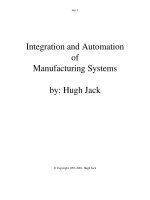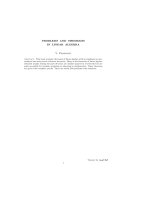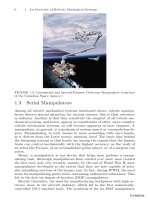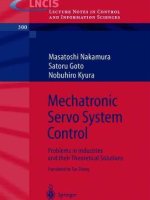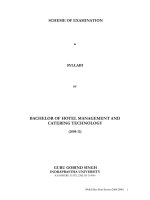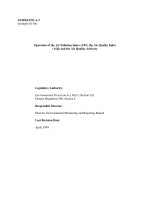LIQUID, GASEOUS AND SOLID BIOFUELS CONVERSION TECHNIQUES pdf
Bạn đang xem bản rút gọn của tài liệu. Xem và tải ngay bản đầy đủ của tài liệu tại đây (18.53 MB, 552 trang )
LIQUID, GASEOUS AND
SOLID BIOFUELS -
CONVERSION
TECHNIQUES
Edited by Zhen Fang
Liquid, Gaseous and Solid Biofuels - Conversion Techniques
/>Edited by Zhen Fang
Contributors
Anne Ruffing, Robert Diltz, Pratap Pullammanappallil, Emad Shalaby, Edilson León Moreno Cárdenas, Deisy Yuliana
Cano Quintero, Elkin Alonso Cortés Marín, László Kótai, Armando Tibigin Quitain, Bezergianni, Petra Patakova, Leona
Paulova, Mojmir Rychtera, Karel Melzoch, Jean-Michel Lavoie, Charalampos Arapatsakos, Michael Köpke, FungMin
Liew, Séan Dennis Simpson, Anli Geng, Fabiana Aparecida Lobo, Fernanda Pollo, Ana Cristina Villafranca, Mercedes De
Moraes, Hongjuan Liu, Amar Kumar Mohanty, Singaravelu Vivekanandhan, Nima Zarrinbakhsh, Manjusri Misra, Valeriy
Chernyak, Iñaki Gandarias, Pedro L. Arias
Published by InTech
Janeza Trdine 9, 51000 Rijeka, Croatia
Copyright © 2013 InTech
All chapters are Open Access distributed under the Creative Commons Attribution 3.0 license, which allows users to
download, copy and build upon published articles even for commercial purposes, as long as the author and publisher
are properly credited, which ensures maximum dissemination and a wider impact of our publications. After this work
has been published by InTech, authors have the right to republish it, in whole or part, in any publication of which they
are the author, and to make other personal use of the work. Any republication, referencing or personal use of the
work must explicitly identify the original source.
Notice
Statements and opinions expressed in the chapters are these of the individual contributors and not necessarily those
of the editors or publisher. No responsibility is accepted for the accuracy of information contained in the published
chapters. The publisher assumes no responsibility for any damage or injury to persons or property arising out of the
use of any materials, instructions, methods or ideas contained in the book.
Publishing Process Manager Iva Simcic
Technical Editor InTech DTP team
Cover InTech Design team
First published March, 2013
Printed in Croatia
A free online edition of this book is available at www.intechopen.com
Additional hard copies can be obtained from
Liquid, Gaseous and Solid Biofuels - Conversion Techniques, Edited by Zhen Fang
p. cm.
ISBN 978-953-51-1050-7
free online editions of InTech
Books and Journals can be found at
www.intechopen.com
Contents
Preface IX
Section 1 Liquids 1
Chapter 1 Biofuels and Co-Products Out of Hemicelluloses 3
Ariadna Fuente-Hernández, Pierre-Olivier Corcos, Romain Beauchet
and Jean-Michel Lavoie
Chapter 2 Production of 2nd Generation of Liquid Biofuels 47
Leona Paulová, Petra Patáková, Mojmír Rychtera and Karel Melzoch
Chapter 3 Biofuels Ethanol and Methanol in OTTO Engines 79
Charalampos Arapatsakos
Chapter 4 Analytical Methodology for Determination of Trace Cu in
Hydrated Alcohol Fuel 109
Fabiana Aparecida Lobo, Fernanda Pollo, Ana Cristina Villafranca
and Mercedes de Moraes
Chapter 5 Gas Fermentation for Commercial Biofuels Production 125
Fung Min Liew, Michael Köpke and Séan Dennis Simpson
Chapter 6 The Promising Fuel-Biobutanol 175
Hongjuan Liu, Genyu Wang and Jianan Zhang
Chapter 7 Biobutanol from Renewable Agricultural and Lignocellulose
Resources and Its Perspectives as Alternative of
Liquid Fuels 199
László Kótai, János Szépvölgyi, Mária Szilágyi, Li Zhibin, Chen
Baiquan, Vinita Sharma and Pradeep K. Sharma
Chapter 8 Metabolic Engineering of Hydrocarbon Biosynthesis for Biofuel
Production 263
Anne M. Ruffing
Chapter 9 Catalytic Hydroprocessing of Liquid Biomass for Biofuels
Production 299
Stella Bezergianni
Chapter 10 Hydrotreating Catalytic Processes for Oxygen Removal in the
Upgrading of Bio-Oils and Bio-Chemicals 327
Iñaki Gandarias and Pedro Luis Arias
Chapter 11 Synthesis of Biomass-Derived Gasoline Fuel Oxygenates by
Microwave Irradiation 357
Armando T. Quitain, Shunsaku Katoh and Motonobu Goto
Section 2 Gases and Other Products 375
Chapter 12 Generation of Biohydrogen by Anaerobic Fermentation of
Organics Wastes in Colombia 377
Edilson León Moreno Cárdenas, Deisy Juliana Cano Quintero and
Cortés Marín Elkin Alonso
Chapter 13 Hydrogen Conversion in DC and Impulse
Plasma-Liquid Systems 401
Valeriy Chernyak, Oleg Nedybaliuk, Sergei Sidoruk, Vitalij
Yukhymenko, Eugen Martysh, Olena Solomenko, Yulia Veremij,
Dmitry Levko, Alexandr Tsimbaliuk, Leonid Simonchik, Andrej
Kirilov, Oleg Fedorovich, Anatolij Liptuga, Valentina Demchina and
Semen Dragnev
Chapter 14 Biofuels from Algae 431
Robert Diltz and Pratap Pullammanappallil
Chapter 15 Biofuel: Sources, Extraction and Determination 451
Emad A. Shalaby
Chapter 16 Conversion of Oil Palm Empty Fruit Bunch to Biofuels 479
Anli Geng
ContentsVI
Chapter 17 Coproducts of Biofuel Industries in Value-Added Biomaterials
Uses: A Move Towards a Sustainable Bioeconomy 491
S. Vivekanandhan, N. Zarrinbakhsh, M. Misra and A. K. Mohanty
Contents VII
Preface
Biomass is a renewable, unevenly geographically distributed resource that can be consid‐
ered sustainable and carbon-neutral if properly managed. It can be converted to high-quali‐
fied gaseous, liquid and solid biofuels with many techniques. This book focuses on the latest
conversion techniques for the production of liquid and gaseous biofuels that should be of
interest to the chemical scientists and technologists.
This book includes 17 chapters contributed by experts around world on conversion techni‐
ques. The chapters are categorized into 2 parts: Liquids and Gases and Other Products.
Part 1 (Chapters 1-11) focuses on liquid biofuels. Chapter 1 reviews pathways for the con‐
version of hemicellulose to biofuels and chemicals. Chapter 2 discusses the production of
cellulosic ethanol. Chapter 3 gives the experimental results of ethanol and methanol used in
Otto engines. Chapter 4 presents analytic methods to determine trace Cu in ethanol. Chapter
5 reviews gas fermentation process for the production of liquid fuels (e.g., ethanol, butanol
and 2,3-butanediol) and other products (e.g., acetic acid and butyric acid). Chapters 6 and 7
overview the production and applications of biobutanol. Chapter 8 describes the metabolic
pathways involved in microbial hydrocarbon fuel synthesis and discusses strategies for im‐
proving biofuel production using genetic manipulation. Thermal conversion and upgrading
techniques (such as catalytic hydroprocessing and microwave irradiation) are introduced in
Chapters 9-11.
Part 2 (Chapters 12-17) describes production methods for gases and other products. Chap‐
ters 12 and 13 introduce hydrogen production by anaerobic fermentation, and DC and im‐
pulse plasma-liquid systems, respectively. Chapter 14 overviews some techniques (e.g.,
anaerobic digestion, fermentation, lipid extraction and gasification) for the production of bi‐
ofuels from algae. Chapter 15 briefly introduces the production of biogas, biodiesel and
ethanol. Chapter 16 comments on various thermal and biological conversions
of oil palm
empty fruit bunch to biofuels. Finally, Chapter 17 proposes a biorefinery concept for the co-
products of biofuels and value-added biomaterials for sustainable bioeconomy.
This book offers reviews state-of-the-art conversion techniques for biofuels. It should be of
interest for students, researchers, scientists and technologists in the engineering and scien‐
ces fields.
I would like to thank all the contributing authors for their time and efforts in the careful
construction of the chapters and for making this project realizable. It is certain to inspire
many young scientists and engineers who will benefit from careful study of these works and
that their ideas will lead us to develop even more advances methods for producing liquids
and gases from biomass resources.
I am grateful to Ms. Iva Simcic (Publishing Process Manager) for her encouragement and
guidelines during my preparation of the book.
Finally, I would like to express my deepest gratitude towards my family for their kind coop‐
eration and encouragement, which help me in completion of this project.
Zhen Fang
Leader of Biomass Group
Chinese Academy of Sciences
Xishuangbanna Tropical Botanical Garden, China
PrefaceX
Section 1
Liquids
Chapter 1
Biofuels and Co-Products Out of Hemicelluloses
Ariadna Fuente-Hernández, Pierre-Olivier Corcos,
Romain Beauchet and Jean-Michel Lavoie
Additional information is available at the end of the chapter
/>1. Introduction
Second generation biofuels are based on the utilisation of non-edible feedstock for the
production either of ethanol to be inserted in the gasoline pool or of biodiesel to be insert‐
ed in the diesel pool. Ethanol is usually produced out of fermentation of C6 sugars (al‐
though other approaches does exist, see [1]) and the latter came, in first generation
ethanol, from starch. In second-generation ethanol, the source of carbohydrate considered
is usually cellulose, which, in turns, is obtained from lignocellulosic biomass. Recent work
by Lavoieet al. [2] have depicted an overview of many types of lignocellulosic biomass
and in most cases, cellulose, although a major component, is not the only one and is ac‐
companied by lignin, hemicelluloses, extractives and, in case of agricultural biomass, pro‐
teins. High grade biomass (as wood chips, sugar cane or even corn) are usually very
expensive (more than 100 USD/tonne) because, in most part, of the important demand re‐
lated to those feedstock in industries and this is why cellulosic ethanol is more than often
related to residual biomass. The latter includes but is not limited to residual forest and ag‐
ricultural biomass as well as energy crops. In all cases, although the feedstock is rather in‐
expensive (60-80 USD/tonne), it is composed of many different tissues (leaves, bark, wood,
stems, etc.) making its transformation rather complex [3]. Industrialisation of second-gen‐
eration biofuel requires specific pre-treatment that should be as versatile as efficient in or‐
der to cope with the economy of scale that has to be implemented in order to make such
conversion economical.
The whole economics of cellulosic ethanol relies first on ethanol, which has a commodity
beneficiates from a quasi-infinite market as long as prices are competitive. Assuming aver‐
age cellulose content of 45-55 % (wt) in the lignocellulosic biomass, the ethanol potential of
lignocellulosic biomass would range between 313-390 L per tonne of biomass converted.
© 2013 Fuente-Hernández et al.; licensee InTech. This is an open access article distributed under the terms of
the Creative Commons Attribution License ( which permits
unrestricted use, distribution, and reproduction in any medium, provided the original work is properly cited.
With an actual market price of 0.48 USD per liter the value of this ethanol would range be‐
tween 150-187 USD per tonne of biomass processed. Since the latter is more expensive to
process (first isolation of cellulose then hydrolysis of cellulose) and considering the fact that
the feedstock is itself expensive, there is a necessity to get an added value out of the remain‐
ing 55-45 % (wt) content. This residual carbon source is composed mostly of hemicelluloses
and of lignin. The latter is a very energetic aromatic-based macromolecule, that has a high
calorific value explaining why many processes converting such biomass (as some pulp and
paper processes) relies on the combustion of lignin to provide part of the energy for the in‐
dustry. It could also serve as a feedstock for the production of added-value compounds and
although the subject is very pertinent to the field, it is out of the scope of this review, which
focuses mostly on C5 sugars derived from hemicelluloses.
Conversion of the carbohydrates is of course an important part of the process although; iso‐
lation of hemicellulose for the lignocellulosic matrix is also crucial for such an approach and
in consequence should also be briefly assessed. For years now, the pulp and paper industry
have worked with lignocellulosic substrates and they have over the year developed many
techniques allowing isolation of hemicelluloses. Chemical processes as soda pulping and
kraft pulping allows isolation of both lignin and hemicellulose whilst protecting the cellulo‐
sic fibres in order to produce the largest amount of pulp possible per ton of biomass. Never‐
theless, in both chemical processes previously mentioned, the hemicellulose are rather
difficult to reach since they are mixed with a variety of organic and inorganic compounds
including lignin as well as the chemicals that were used for the pulping process. During the
last decades, the pulp and paper industry have started to look toward other processes that
could allow a preliminary removal of hemicelluloses in order to avoid a complicated and ex‐
pensive isolation after a chemical pulping process.
Amongst the techniques used for prehydrolysis, treatments with hot water catalyzed or not
have been investigated in details in literature. As an example, Schildet al. [4] performed a
preliminary extraction with water (via auto-hydrolysis) or with alkaline water prior to soda
pulping in order to recuperate the hemicellulose prior to pulping. Similar testing was also
performed on northern spruce with pressurised hot water in the presence of sodium bicar‐
bonate [5]. Hot water extractions were also performed at temperature around 170
°
C at dif‐
ferent pH (the latter were adjusted with a phthalate buffer) and these experiments showed
that control of pH was crucial in order to extract more of the hemicelluloses (up to 8 % wt on
original biomass) [6]. Hot water extractions at similar temperature range have also been per‐
formed on maple [7] as well as on sugarcane bagasse [8]. Overall the hot water pretreatment
may be a very promising approach for isolation of hemicelluloses although reported rates
did not go far over 10 % because of the necessity to preserve the cellulosic fibres in order to
avoid losses for papermaking. Acid catalyst has also been used as pretreatment to remove
hemicellulose prior to pulping as reported by Liuet al. [9]. Utilisation of sulphuric acid, al‐
though very efficient to remove hemicellulose may also have an impact on cellulose thus re‐
ducing the pulp production rates.
Another process that could lead to isolation of hemicellulose is the organosolv process,
which is to a certain extent comparable to classical chemical pulping in that sense that the
Liquid, Gaseous and Solid Biofuels - Conversion Techniques4
technique allows simultaneous removal both for lignin and hemicelluloses. However, in‐
stead of using only an aqueous mixture of ions, the process relies on the utilisation of a com‐
bination of ions (usually alkaline) in a 50/50 mixture of aqueous organic solvent. In most
cases, the solvent is methanol for obvious economic reasons although other solvents as buta‐
nol and certain organic acids have also been investigated to the same purposes. Recent work
by Wanget al. [10]have shown that in an organosolv process using different solvent as well
as different catalyst with poplar, sodium hydroxide was shown to be the best catalyst for
hemicellulose removal from the pulp. Recent work by Brosse et al. [11] also showed that for
Miscanthus Gigantheus, an ethanol organosolv process combined with an acid catalyst (sul‐
phuric) lead to removal of most of the hemicelluloses and lignin from the original biomass.
Finally, another approach that could lead to isolation of hemicellulose from a lignocellulosic
matrix is steam processes. This technique relies on impregnation of the feedstock with water
(either catalyzed or not) then treatment under pressure at temperature ranging from 180-230
°
C for a certain period of time after which pressure is relieved suddenly thus creating an
“explosion” of the feedstock. Such process could lead, depending on the operating condi‐
tion, to the isolation of either hemicellulose or lignin in two steps or in a single step. Our
team has demonstrated the feasibility of both processes for different substrates [12-14].
Independently of the substrate or the technique used for the isolation of the hemicelluloses,
conversion of lignocellulosic biomass, either for the production of paper or for the produc‐
tion of biofuels requires a complete utilization of the carbon compound found in biomass.
Once the hemicelluloses are isolated from the original feedstock, they can undergo different
types of transformation leading to different added value compounds that could lead to in‐
crease the margin of profit for the industries in the field.
Hemicelluloses account for 15-35 % of lignocellulosic biomass dry weight [2] and they are
usually composed of different carbohydrates as well as small organic acids as acetic and for‐
mic acid. Glucose and xylose are often the most abundant sugars in hemicelluloses hydroly‐
sis although mannose, arabinose and galactose might also be present in lower
concentrations. The carbohydrate compositions of some lignocellullosic biomass are shown
in Table 1. Whilst the C6 sugars could easily be fermented to ethanol following detoxifica‐
tion of the mixture, C5 sugars remains hard to convert to ethanol, mostly because classical
yeasts don’t metabolise them and the genetically modified organism that ferment C5 sugars
are usually slower than classical organisms used in the production of etanol from C6 sugars.
Nevertheless, even if ethanol production may remain a challenge, other alternatives could
be considered, both on the chemical and on the microbiological point of view, to allow con‐
version of C5 sugar into added value products.
Carbohydrates tend to react in acidic, basic, oxidative or reductive mediums and therefore,
numerous do arise for the conversion of C5 sugars. Although many options are available,
this review will focus solely on 4 different pathways: acid, base, oxidative, and reductive.
Each of these pathways could be inserted in an integrated biorefinery process where each of
the fractions could be isolated and upgraded to high value compounds (see Figure 1).
Biofuels and Co-Products Out of Hemicelluloses
/>5
Components
(wt%)
Energy crops Agricol residues
Forest
residues
Coniferous
Switchgrass
[15]
Miscanthus
[16]
Wheat
Straw [15]
Corn
Stover [17]
Aspen
[18]
Loblolly
Pine [19]
Glucan 38.5 55.5 39.2 36.2 52.4 36
Xylan 26.3 12.4 24.6 20.1 14.9 7.5
Galactan 1.16 - - 1.45 2.2 2.5
Mannan 0.13 - - - 2.3 8.2
Arabinan 3.41 - 1.9 3.0 0.9 1.6
Table 1. Carbohydrate composition of some lignocellulosic biomass.
Figure 1. Potential utilization of hemicelluloses in an optimized conversion process for residual lignocellulosic biomass
where C6 sugars are converted to ethanol, lignin and extractives to other added value products.
In this review, emphasis will be made on the recent work made for each of these conversion
pathways both on the chemical and on the biochemical pathways. The review will focus on
these 4 approaches also for their generally simple nature that would make them adaptable
to an industrial context. These results will be compared to classical fermentation processes
to produce ethanol with different types of organisms that can metabolise C5 sugars.
2. Conversion of xylose under an acid catalyst
2.1. The chemical pathway
Either in cyclic or aliphatic form, xylose then tends to dehydrate thus leading to the produc‐
tion of furfural whilst losing three molecules of water. Although this approach could explain
the formation of furfural, it is not the sole options and many detailed reports have shown,
by correlating the intermediaries with the actual structure, could be formed by many ap‐
Liquid, Gaseous and Solid Biofuels - Conversion Techniques6
proaches depending on the reactant as reported by Marcotullio et al. [20] using halogen ions
and proceeding only via the aliphatic form or as reported by Nimlos et al. [21] either via an
aliphatic or a cyclic pathway (D-xylopyranose). Many different types of acid catalyst, either
Brønsted or Lewis have been tested for the production of furfural. Although most of the
acids reported in literature have been efficient so far for the production of the targeted mole‐
cule, one of the major side-reaction of furfural is polymerisation which influences the con‐
version rates and the selectivity of most of the processes reported in literature. An example
of the abundance of research on this specific conversion is shown in Table 2 for different de‐
hydration reactions under acid catalyst
Catalyst Conversion Reference
H-Mordenite 98% [22]
Sulphonic acid/Silica surface 99% [23]
1-methylimidazole 91% [24]
KI, KCl (dilute acid) 88% [20]
NaCl, H
2
SO
4
83% [25]
1-alkyl-3-methylimidazolium 84% [26]
NaCl, HCl 78% [27]
Aluminium chloride Hexahydrate 76% [28]
Amberlyst 70 75% [29]
Zeolite H-Beta 74% [30]
MCM-22, ITQ-2 70% [31]
FeCl
3
71% [32]
Nafion 60% [33]
Keggin type acids 62% [34]
Vanadyl pyrophosphate 53% [35]
Table 2. Molar conversion to furfural in relationship with the catalyst used for the dehydration of xylose to furfural
under acid catalyst.
For these reactions, the temperature is generally between 140-240
°
C under proportional
pressure allowing the mixture to remain liquid. Many researches also use a co-solvent, often
toluene in order to isolate furfural from the aqueous mixture. The reason why toluene is so
popular to this purpose is mostly related to the fact that toluene has affinity for fufural thus
inhibiting its polymerization.
Heterogeneous catalyst has been proven to be very efficient for the process [22,23] although
polymerisation tend to reduce the surface activity thus leading to a short-term deactivation
of the catalyst. On the other hand, homogeneous catalyst was also shown to be efficient but
at this point the whole technique relies on how the organic solvent is dispersed in the aque‐
ous mixture. Reducing the size of the organic solvent particles in water (or vice-versa) to the
maximum should allow the best transfer between the aqueous phase to the organic phase,
Biofuels and Co-Products Out of Hemicelluloses
/>7
assuming of course that furfural has suitable affinity for the solvent and that the partition
coefficient favours the solvent.
Production of furfural itself is of course of significant interest because, amongst many fac‐
tors, this chemical is commonly used in the industry as a solvent (mostly in oil chemistry).
The average world production for furfural is 250 000 t/y and the actual market price evolves
around 1000 USD/t [36] with recent market value reported to be closer to 1600 USD/tonne
[37]. Furfural can also be a gateway to other products that could be used either as biofuels or
as biomolecules. Example of such would be furfuryl alcohol via partial reduction of furfural
(see Figure 2 below).
Figure 2. Reduction of furfural to furfuryl alcohol.
Furfuryl alcohol is also of interest since it is used as resins, adhesives and wetting agent, it
has been mentioned that most of the 250 Kt/y of the furfural production is oriented toward
production of furfuryl alcohol. The market value of this compound has been reported to be
around 1800-2000 USD/tonne [38] and many reports in open literature mentions high selec‐
tivity for the conversion of furfural with iridium and ruthenium catalyst [39], rhodium [40],
iron [41] and with zirconium oxide [42].
Another possible target for the transformation of furfural is for the production of 2-meth‐
yltetrahydrofuran (Me-THF) (see Figure 3). The latter is actually accredited as an additive
for fuel and therefore, the possible market is virtually very important. It is also used in
the petroleum industry to replace tetrahydrofuran (THF) that usually comes from non-re‐
newables.
Figure 3. Reduction of furfural to 2-methyltetrahydrofuran.
Reduction of furfural to Me-THF seems to represent an important challenge since there is
fewer reports mentioned in literature on the subject, as compared, as an example, to the re‐
duction of furfural to furfuryl alcohol. Wabnitz et al. [43, 44] patented a one and two step
process allowing conversion of furfural to Me-THF under a palladium-based catalyst and a
mixture of palladium and copper oxide and chromium oxide as for the two step process.
Liquid, Gaseous and Solid Biofuels - Conversion Techniques8
Lange [45] patented a process using palladium and titanium oxide whilst Zheng et al. [46]
worked with a copper alloy. Value for Me-THF could be estimated from the price of THF
which is around 3000 USD/tonne [47] and the gap between the value of furfural and Me-
THF could justify the process although hydrogen value can be estimated to be around 4.5
USD/Kg (estimated with the actual price of natural assuming reforming of the latter).
Another potentially interesting approach for a transformation of furfural would be decar‐
boxylation to furan. The general process is depicted in Figure 4 below.
Figure 4. Decarboxylation of furfural to furan.
Many researches have focused on decarboxylation including work by Zhang et al. [48] who
mentioned decarboxylation with potassium-doped palladium, and Stevens et al. [49] who re‐
ported conversion with copper chromite in supercritical CO
2
.
Results reported in literature show that xylose, under an acid catalyst, tend invariably to de‐
hydrate to furfural thus limiting the possibilities for side-products in such specific condi‐
tions. The acids could be Brønsted or Lewis type, all lead to the production of furfural
furthermore when temperature are raised above 150
°
C.
2.2. The biological pathway
Although furfural is a very common route for the conversion of xylose under an acid cata‐
lyst, furfural itself is rarely related to microorganisms in that sense that it is often considered
as an inhibitor instead of a metabolite. Nevertheless, to the best of our knowledge, no report
mentioned a biological conversion of xylose to furfural.
3. Conversion of xylose under a base catalyst
3.1. The chemical pathway
The interaction between xylose and bases, either Brønsted or Lewis, is rather less reported in
the literature when compared to the acid conversion of xylose to furfural indicated in the
previous section. Many very different reactions have been reported as in the case of Popoff
and Theander [50] that have quantified the cyclic compounds produced after a base-cata‐
lyzed reaction of pure D-xylose at 96
°
C for 4 hours. The produced compounds are rather
peculiars in comparison to other work made on the subject (see Figure 5) since most of the
reported compounds are aromatics. The presence of aromatics may be a result that the reac‐
Biofuels and Co-Products Out of Hemicelluloses
/>9
tion time was long and the isomerisation that was required in order to induce such reaction
was efficient. Johansson and Samuelson [51] tested the effect of alkali treatments (NaOH) on
birch xylan and contrarily to the previous research; they found that the treatment led to the
production of a variety of organic acids. Testing on untreated xylene showed that most of
the organic acids were already obtained from xylans and the most distinctive impact was
observed after a 2 day test at 40
°
C where the concentrations of L-galactonic and altronic
acids increased significantly which could be related to a less severe treatment of xylans that
also include C6 sugars.
Figure 5. Cyclic and aromatics obtained from the based-catalysed treatment of D-xylose under a sodium hydroxide
catalyst where (1) 2-hydroxy-3-methylcyclopent-2-enone; (2) 2-hydroxy-3,4-dimethylcyclopent-2-enone; (3) pyrocate‐
chol; (4) 3-methylbenzene-1,2-diol; (5) 4-methylbenzene-1,2-diol; (6) 3,4-dimethylbenzene-1,2-diol; (7) 2-methylben‐
zene-1,4-diol; (8) 1-(2,5-dihydroxyphenyl)ethanone; (9) 1-(3,5-dihydroxyphenyl)ethanone; (10) 1-(3,4-
dihydroxyphenyl)ethanone; (11) 3,4-dihydroxybenzaldehyde; (12) 1-(2,3,4-trihydroxy -5-methylphenyl)ethanone; (13)
1-(2,3-dihydroxy-6-methylphenyl)ethanone.
El Khadem et al. [52] studied the effect of xylose conversion in an alkali medium at low tem‐
peratures (room) and for long periods (1-4 weeks) and one of the interesting features of his
work was that the process did lead to the epimerization of sugars, but furthermore, it leads
to the production of C6 sugars most probably from a reverse aldol reaction. Among the sug‐
ars that were formed during the reaction, conversion of xylose was shown to be more effi‐
cient to lyxose (18 %) and arabinose (15 %) with a decrease observed for most of the
compounds between 1 and 4 weeks (see Figure 6). A vast majority (more than 50 %) of xy‐
lose remains on its original form and the reaction leads to the production of 1 % glucose and
2.5 % of sorbose, both are C6 sugars.
Liquid, Gaseous and Solid Biofuels - Conversion Techniques10
Figure 6. Major epimerisation products from 1-4 week reaction of D-xylose in a pH 11.5 KOH solution at room tem‐
perature.
Xylose, as the other carbohydrates, is converted to smaller organic acids when reacted with
a strong alkali medium. As an example, Jackson et al. [53] have demonstrated that the con‐
version of xylose to lactic acid could reach 64 % (molar) accompanied by glyceric acid. Al‐
though they did not used xylose but rather ribose and arabinose, they were able to reach
conversions between 35-43 % into lactic acid using potassium hydroxide as catalyst under
microwave irradiation [54]. Rahubadda et al. [55] have provided a mechanism for the con‐
version of xylose to lactic acid under a base catalyst. The simplified pathway is depicted in
Figure 7 below.
Figure 7. Conversion of D-xylose to lactic acid via the methylglyoxal pathway.
Biofuels and Co-Products Out of Hemicelluloses
/>11
They mentioned in this report that methylglyoxal is most probably derived from glyceralde‐
hyde as depicted in Figure 8 below. The possible reaction leading to methylglyoxal may in‐
volve an E2 reaction on C2 leading to removal of the hydroxyl group on C3 then a keto-enol
rearrangement to methylglyoxal.
Figure 8. Conversion of glyceraldehyde to methylglyoxal.
Onda et al. [56] achieved a conversion rate of more than 20 % when using xylose as a feed‐
stock with a carbon-supported platinum catalyst in alkali solution. In a recent report by Ma
et al. [57], it was shown that using model compounds, different carbohydrates tend to con‐
vert into lactic acid at different levels. Fructose was shown to be more effectively converted
to lactic acid than glucose and finally than xylose. The work also showed a correlation be‐
tween the amount of catalyst (varying from 1-3 % wt.) of NaOH, KOH and Ca(OH)
2
respec‐
tively. Part of the work by Aspinall et al. [58] was aimed at the non-oxidative treatment of
xylans from different substrates using sodium hydroxide as solvent. The reaction was per‐
formed at room temperature for 25 days and amongst the products that emerged from this
reaction, a majority was acidic and lactic acid as well as formic acid were the two major
products. Other work by Yang et al. [59] showed that higher temperature treatments of xy‐
lose (200
°
C) in a Ca(OH)
2
solution produced about 57 % (mol.) of lactic acid with 2,4-dihy‐
droxybutanoic acid in second with 10 % (mol.). The same conversion patterns were
observed by Raharja et al. [60] with production rates for lactic acid above 50 %.
3.2. The biological pathway
Amongst the different options for the conversion of xylose reported in the previous chap‐
ter, production of lactic acid via the microbial route is a vastly studied field [61-63] since
currently, all of the production of lactic acid at an industrial scale in the world is biologi‐
cally based. Traditionally, the concept evolves around fermenting carbohydrate-based syr‐
up by homolactic organisms, mostly lactic acid bacteria (LAB). The most common
carbohydrate-based substrates used to this purpose may be molasses, corn syrup, whey,
sugarcane or even beet bagasse. Highly efficient LAB includes Lactobacillus delbrueckii, L.
Liquid, Gaseous and Solid Biofuels - Conversion Techniques12
amylophilus, L. bulgaricus and L. leichmanii. Mutant Aspergillus niger has also been reported
to be effective at an industrial scale [64]. LAB have the particularity to possess an homo‐
fermentative metabolism producing only lactic acid as extracellular waste product, instead
of the heterofermentative pathway yielding by-products such as aldehydes, organic acids
and ketones. The catabolic pathway yielding lactic acid is essentially the same across all
organisms; the pyruvate intermediate is converted to lactic acid by a lactate dehydrogen‐
ase (LDH). Thus for hexose sugars, the theoretical yield is 2 moles of lactate per mole of
sugar (or 1g sugar for 1g lactate). This enzymatic catalysis has the advantage over its
chemical counterpart to be stereospecific: both L-lactate-dehydrogenase (L-LDH) and D-
lactate-dehydrogenase (D-LDH) exist, generating either L-lactate or D-lactate respectively
[65]. Both are NAD-dependant (nicotinamide adenine dinucleotide) and may be found
alone or together in wild lactate-producing microbial strains. Since optical purity of lac‐
tate is a major requirement for the lactate industry, research focuses on stereospecificity as
much as yields and productivity [61,66-70].
An efficient lactate producer has to display specific attributes, mainly the adaptability to
low-cost substrates, high selectivity of desired enantiomer (L, D or both), high optimal tem‐
perature for decreased contamination risks, low pH tolerance and high performances (yield
and productivity). LAB display appreciable performances, but lack a low pH tolerance,
which implies uses of a pH control apparatus during the fermentation process. LAB optimal
pH is near neutral, but the pKa of lactic acid being 3.8, an alkali agent, usually Ca(OH)
2
,
must be used thus generating calcium lactate. After typical batch fermentation, the medium
is acidified with H
2
SO
4
therefore regenerating and purifying the lactic acid [64]. Another
drawback of LAB is their requirement for a complex growth medium, since they are auxo‐
troph for certain amino acids and vitamins [71]. In order to overcome this problem, many
fungi were also investigated for lactate production. Strains of Rhizopus, Mucor and Monilla
sp. have shown potential whilst other fungi even displayed amylolytic activity, which could
lead to a direct starch-to-lactate conversion [72-74].
Most researches still focuses on hexose conversion, and research group have optimized
strains and process strategies in order to obtain high lactate titers, yields and productivities.
Ding and Tan [75] developed a glucose fed-batch strategy using L. casei and generating up to
210 g/L of lactic acid with a 97 % yield. Chang et al. [76] proposed a continuous high cell
density reactor strategy yielding a titer of 212.9 g/L and productivity of 10.6 g/L/h with Lb.
rhamnosus. Dumbrepatil et al. [77] created a Lb. delbrueckii mutant by ultraviolet (UV) muta‐
genesis producing 166 g/L with productivity of 4.15 g/L/h in batch fermentation. Genetically
engineered non-LAB biocatalysts yet have to match the performances of highly efficient
wild LAB. In fact, C. glutamicum, S. cerevisiae and E. coli recombinant have been developed,
but with limited success [61].
The search for lignocellulose-to-lactate biocatalysts have led to the discovery of many
strains of pentose-utilizing LAB. Lb. pentosus ATCC8041 [78, 79], Lb. bifermentans
DSM20003 [80], Lb. brevis [81], Lb. Plantarum [82], Leuconostoc lactis [83, 84], and E. mundtii
QU 25 [85, 86]. Lactic acid produced from xylose per say has been investigated by few
[84,85, 87, 88], but with mitigated results, mainly due to the fact that the pentose-utilizing
Biofuels and Co-Products Out of Hemicelluloses
/>13
LAB do not perform as well in pentoses as in hexoses-rich metabolism. This phenomenon
is most likely due to the fact that pentoses are metabolized in the PK pathway (phospho‐
ketolase), thus for a given strain, even if hexoses are fermented through an homofermen‐
tative route, pentose will yield heterofermentative products (i.e. acetic and lactic acid) [78,
89]. Nevertheless, Tanaka et al.[84] have shown that in addition to the PK, L. lactis could
metabolize xylulose-5-phosphate (X5P), an intermediate pentose catabolite, through the
pentose phosphate pathway (PPP). The theoretical yield through the PPP is 5 moles of lac‐
tate for 2 moles of pentoses, but through the PK it decreases to 1:1 [61], thus, the conver‐
sion advantage of the PPP is obvious. Okano et al. [87,89] demonstrated this approach by
creating a pentoses-utilizing Lb. plantarium recombinant in which the native L-lactate de‐
hydrogenase (L-LDH) gene was disrupted, leaving only the homologous D-lactate dehy‐
drogenase (D-LDH) active. However, this strain produced both acetic and D-lactic acid;
hence the PK gene (xpk1) was substituted by a heterologous transketolase (tkt) from L. lac‐
tis, thereby shifting heterolactic fermentation to a homolactic one.
Modification of yeast strains in order to achieve xylose-to-lactate conversion has also been
investigated, as an example Ilmen et al. [90] expressed the L-LDH gene from L. helveticus
in P. stipitis and was able to reach a titer of 58 g/L of lactate with a yield of 58 %. These
results were obtained despite the fact that no effort had been made to silence the native
PDC/ADH (pyruvate decarboxylase/alcohol dehydrogenase) ethylic pathway, consequent‐
ly 4.5 g/L of ethanol was simultaneously produced as the endogenous PDC rivalled
against the recombinant L-LDH for pyruvate. Tamakawa et al. [88] went further by trans‐
forming C. utilis, disrupting the native pdc1 gene, and expressing heterologous LDH, XR
(xylose reductase), XDH (xylitol dehydrogenase) and XK (xylulokinase) enzymes. Further‐
more, to prevent the redox imbalance, they increased the XR’s NADH (reduced nicotina‐
mide adenine dinucleotide) affinity by site-directed mutagenesis. In batch culture this
recombinant was able to yield titers up to 93.9 g/L of lactate at a yield of 91 %. Table 3
shows the most recent and most efficient strains developed for lactic acid production,
both from hexoses and pentoses.
Strain Gen Eng Str Medium Process
LA
(g/L)
Tf
(h)
Yield
(g/g)
Prd
(g/L/h)
Ref
E. mundtii QU 25
- Cellobiose Batch 119 106 0.83 1.12 [86]
- Xylose Batch 86.7 0.84 0.9 [85]
-
Glucose/
cellobiose
Batch 35.1 15 0.91 2.99 [86]
Lactobacillus sp.
RKY2
-
Wood
hydrolysates*
Continuous
w/cell
recycling
27 - 0.9 6.7 [91]
Liquid, Gaseous and Solid Biofuels - Conversion Techniques14
Strain Gen Eng Str Medium Process
LA
(g/L)
Tf
(h)
Yield
(g/g)
Prd
(g/L/h)
Ref
Lb. bifermentas
DSM 20003
-
Wheat bran
hydrolysates
Batch 62.8 60 0.83 1.17 [80]
Lb. casei NCIMB
3254
-
Cassava
bagasse
Batch
SSF**
83.8 60 0.96 1.4 [92]
Lb. delbrueckii
Uc-3
UV
mutagenesis
Cellobiose Batch 90 40 0.9 2.25 [93]
Molasse Batch 166 40 0.95 4.15 [77]
Lb. lactis RM 2-24
UV
mutagenesis
Cellobiose Batch 80 48 0.8 1.66
[94]
Cellulose Batch SSF 73 48 0.73 1.52
Lb. plantarum
ΔldhL1-xpk1::tkt
Disruption of
endogenous LDH
gene.
Replacment of
endogenous PK
(xpk1) gene with
heterologous tkt
to redirect the PK
pathway to the
PPP.
Arabinose Batch 38.6 28 0.82 1.37 [89]
Lb. plantarum
ΔldhL1-xpk1::tkt-
Δxpk2
Idem as above.
Disruption of 2nd
PK gene (xpk2) to
terminate
acetate
production.
Xylose Batch 41.2 60 0.89 0.67 [87]
Lb. rhamnosus
ATCC 7469
-
Paper
Sludge
Batch
SSF
73 168 0.97 0.45 [95]
Lb. rhamnosus
ATCC 9595
(CECT288)
-
Apple
pomace
Batch 32.5 6 0.88 5.41 [96]
L. lactis IO-1 - Xylose Batch 33.3 - 0.68 - [84]
S. cerevisiae
recombinant
Replacement of
native pdc1 and
pdc5 by
heterologous
bovine L-LDH
gene.
Glucose Batch 82.3 192 0.83 0.43 [97]
Biofuels and Co-Products Out of Hemicelluloses
/>15

